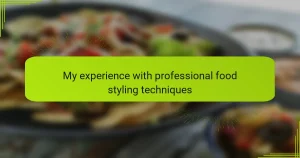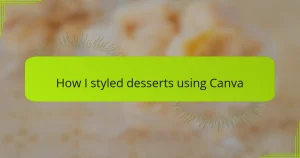Key takeaways
- Understanding ingredient roles and balancing flavors is crucial for successful dessert recipes and tastings.
- Thoughtful presentation, portion sizes, and atmosphere significantly enhance the dessert tasting experience.
- Engaging guests with stories and providing palate cleansers can create a memorable and enjoyable event.
- Gathering feedback through open-ended questions and clear labeling fosters insightful discussions and ensures a welcoming environment.

Understanding Dessert Recipes Basics
When I first started exploring dessert recipes, I quickly realized that understanding the basics made all the difference. Knowing the role of each ingredient—whether it’s sugar for sweetness or eggs for structure—helped me feel confident rather than overwhelmed. Have you ever wondered why some cakes turn out dense while others are light and fluffy? It often comes down to mastering these fundamental details.

Choosing Desserts for Tasting Events
Choosing desserts for a tasting event felt like selecting characters for a play—each dessert needed its own voice. I wanted variety, so I picked options that showcased different textures and flavors, from silky mousses to crunchy tarts. Have you ever noticed how a mix of creamy, fruity, and chocolaty treats keeps everyone excited?
One time, I learned the hard way that too many rich desserts can overwhelm the palate. Since then, I make sure to balance sweet intensity with lighter, refreshing choices like citrus-based sweets. It’s all about creating a journey for the taste buds, not just piling on sugar.
I also considered portion size carefully—small bites work best so guests can savor multiple flavors without feeling too full. It’s amazing how thoughtful planning around dessert selection can turn a simple gathering into a memorable tasting experience. Have you tried tasting desserts this way before? It truly changes how you appreciate each flavor.

Planning the Dessert Tasting Setup
Setting up the tasting area was one of those moments where I realized details really matter. I arranged the desserts on simple white plates to let their colors and textures speak for themselves. Have you ever noticed how a clean, uncluttered presentation just makes you want to dig right in?
I also thought about flow—how guests would move from one dessert to the next without feeling rushed or overwhelmed. Spacing out the treats with little cards describing each one gave a sense of order and added a touch of excitement. It felt like I was guiding everyone on a delicious little adventure.
One thing I underestimated at first was lighting. Natural light made everything look more inviting, but when that wasn’t available, soft, warm lighting saved the day. I’ve learned that the right atmosphere makes a dessert tasting feel special, almost like you’re stepping into a cozy pastry shop instead of just someone’s home. Have you experienced that kind of vibe before? It truly enhances the whole event.

Organizing Dessert Preparation Process
Getting the dessert preparation process organized was a game-changer for me. I found that breaking down tasks by dessert type helped me stay on track—like baking cakes first, then moving on to assembling mousses or chilling puddings. Have you ever felt that frantic rush when everything seems to need attention at once? Planning ahead saved me from that stress and made the whole experience much more enjoyable.
Timing turned out to be my secret weapon. Some desserts, like meringues, demanded precise oven temperatures and cooling times, while others needed hours to set in the fridge. By mapping out a schedule, I avoided the last-minute scramble and could focus on quality rather than speed. It’s surprising how much calmer and more focused you feel when your kitchen has a clear rhythm.
I also learned to prep ingredients ahead of time—chopping nuts, measuring spices, and even pre-making syrups. This little step might sound simple, but it gave me precious minutes to troubleshoot or add finishing touches on event day. Do you prep like this, or dive right into baking? From my experience, a bit of prep work makes a huge difference in how smoothly dessert day goes.

Hosting the Dessert Tasting Experience
Hosting the dessert tasting experience felt like orchestrating a delicious symphony, where every detail mattered. I made sure to welcome my guests warmly, encouraging them to take their time savoring each bite rather than rushing through the lineup. Have you ever noticed how a relaxed atmosphere invites more genuine enjoyment and conversation?
I also learned that engaging guests by sharing little stories or fun facts about each dessert added a personal touch that sparked curiosity. It transformed the event from just tasting sweets into a shared journey of discovery, which made the whole experience more memorable for everyone involved.
One thing that truly surprised me was how much the little extras—like providing palate cleansers such as sparkling water or mild crackers—helped keep flavors distinct and fresh. It’s amazing how small thoughtful gestures can elevate the entire event and keep guests coming back for more. Have you tried something like this before? It really changes the way you appreciate desserts.

Gathering Feedback from Guests
Gathering feedback from guests became one of the most insightful parts of the event for me. I asked simple, open-ended questions like, “Which dessert surprised you the most?” or “Was there a flavor you wished had been stronger?” This approach not only sparked fun conversations but also gave me honest insights I wouldn’t have expected.
I noticed that some guests were shy about sharing their thoughts right away, so I provided small feedback cards that they could fill out anonymously. It was amazing to see the variety of opinions and suggestions that came back — some were lighthearted, others surprisingly detailed. Have you ever considered how different perspectives can open your eyes to new ideas you might never have thought about yourself?
One thing I learned the hard way is that timing matters when asking for feedback. Catching people right after tasting or toward the end of the event usually yielded the most genuine responses. It made me realize that feedback is not just about collecting opinions but about creating moments where guests feel comfortable and eager to share their experience.

Tips for Successful Dessert Events
One tip I’ve found invaluable is to keep the dessert portions small and manageable. It might seem obvious, but when guests can comfortably sample a handful of bites without feeling overwhelmed, the whole event feels more relaxed and enjoyable. Have you ever attended a tasting where you left feeling stuffed rather than excited? That’s precisely what I try to avoid by focusing on bite-sized delights.
Another thing I always pay close attention to is clear labeling. Simple cards with dessert names and a few key ingredients not only inform but also spark curiosity. I remember one event where a guest’s allergy concern was quickly resolved just because the labels were easy to read and detailed. It’s a small step, but it creates a safer and more welcoming environment for everyone.
Finally, I can’t stress enough the importance of pacing. Rushing through desserts turns the experience into a blur, but a steady, unhurried pace lets each flavor shine. When I host, I often encourage my guests to chat and breathe between tastings—it’s amazing how much more memorable the event becomes when everyone takes the time to savor each bite. How do you usually pace your tasting events? In my experience, slowing down truly deepens the enjoyment.




